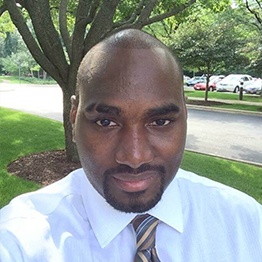Keith’s Story
Keith's Story
Keith Philizaire lived through years of anguish and pain medication for severe phantom limb pain after the amputation of his leg. A childhood accident had led to years of surgeries and devices to lengthen his leg. These therapies did “more harm than good,” according to Keith, and he ultimately opted to have his leg amputated.
Things seemed to be going well up to three months following the amputation. Then Keith noticed he was able to feel his phantom foot, and then his phantom leg. Those sensations turned into extreme phantom limb pain.
“If you can imagine, for two years, it felt like my [phantom] leg was being cut off over and over again,” he said
Keith was sent from one doctor to another, but none of them could help. “They just kept feeding me medication,” he said. “I was on a cocktail of five to six different medications.” This regimen included 600 mg of Lyrica, which robbed him of his memory and ability to function.
Keith’s unremitting pain left him seriously considering suicide as his only out. For two years, he was unable to work, unable to drive, unable to wear his prosthetic ― unable do much of anything
A life-changing referral
But then a series of referrals led Keith to the solution. A doctor at the NorthShore University Health System in Chicago referred Keith to another doctor who specialized in treating amputees. That doctor was familiar with a study of targeted muscle reinnervation (TMR) surgery for post-amputation nerve pain being conducted at Northwestern University.
“At first I didn’t want to go because I was tired of going from doctor to doctor. I got used to doctors saying they don’t know what’s wrong with me. But when I met with the surgeon, the only thing I could hear him say was that he could fix me. They did the surgery and saved my life,” he said.
Keith’s advice to other amputees experiencing nerve pain is to seek out a physician who knows something about amputees. Connect with amputee groups like the Amputee Coalition. Find a doctor at a research hospital. Do your own research. Avoid medications. Then weigh your options. If TMR is an option, he highly recommends it.
Following TMR, Keith has been able to return to a full and active life. “I’m pain-free and no longer using any medications. I’ve returned to work and can drive my car. I’m able to take my daughters to the park and the movies, and I even rode a bike with my prosthetic leg.”
Keith commented that, during his ordeal, he had no one to turn to for help. “If it hadn’t been for [the referral of] one doctor, I probably wouldn’t be here today.”
Keith is giving back by counseling patients who are considering TMR and using a prosthetic device. He is helping to spread the word about TMR as an option for post-amputation pain by speaking with prosthetist groups and other healthcare providers. He also participates as a prosthetic model for the Northwestern Prosthetic Teaching Program.
